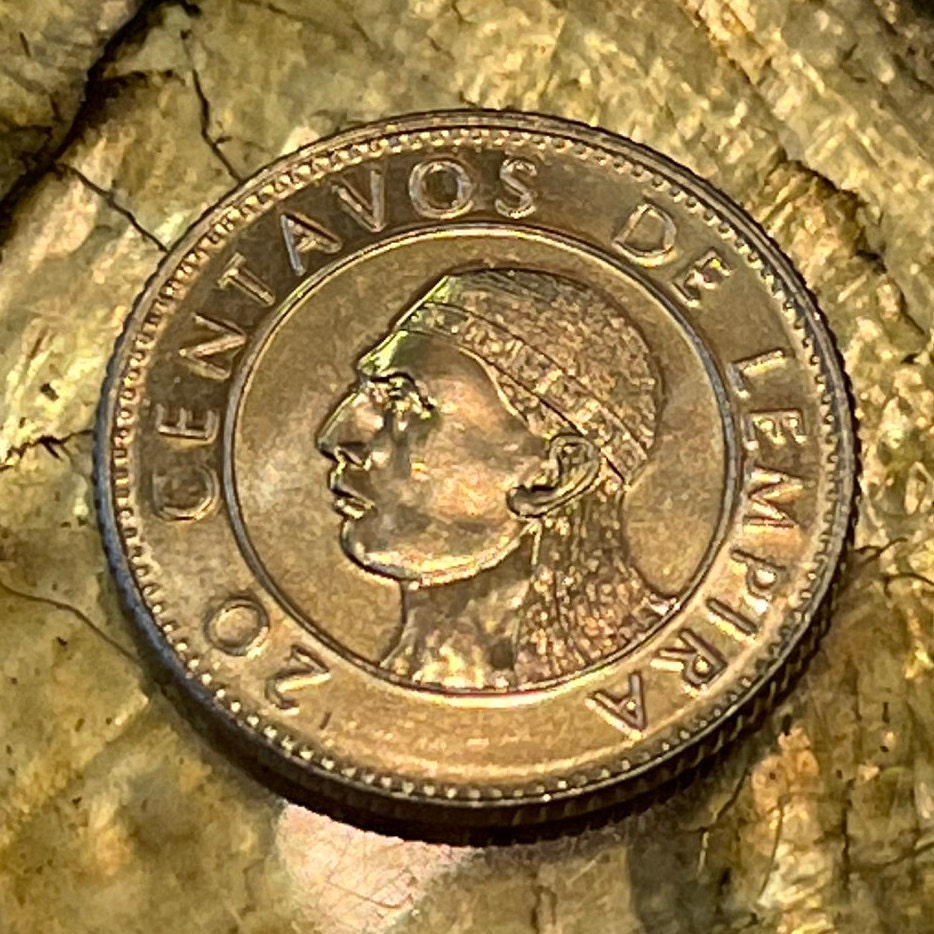elemintalshop
Chief Lempira 20 Centavos Honduras Authentic Coin Money for Jewelry and Craft Making
Chief Lempira 20 Centavos Honduras Authentic Coin Money for Jewelry and Craft Making
Couldn't load pickup availability
Lempira 20 Centavos Honduras Authentic Coin Money for Jewelry and Craft Making
Obverse: Honduran coat of arms: the triangle Coat of Arms of the Central American federation with a volcano between two towers in an oval. Behind it are a sun and a rainbow. On the oval are two cornucopias and a quiver of arrows. Under the oval is a landscape with oak and pine trees, and mining equipment.
Lettering: REPUBLICA DE HONDURAS
REPUBLICA DE HONDURAS; LIBRE SOBERANA E INDEPENDIENTE
15 DE SEPTIEMBRE
1821
Translation: Honduran Republic
Republic of Honduras, Free, Sovereign, and Independent
September 15, 1821
Reverse: Portrait of Chief Lempira (without feathers) facing left within a circle.
Lettering: 20 CENTAVOS DE LEMPIRA
Translation: 20 Lempira Cents
Comments: Lempira, the present currency of Honduras, was introduced in 1931 replacing the Peso. The Lempira is divided into 100 Centavos. The currency is named after Lempira, a chieftain of the indigenous Lenca people, who waged war against Spanish occupation of the country during 16th century. He is revered as a national hero.
Features
Issuer Honduras
Period Republic (1839-date)
Type Standard circulation coin
Years 1978-1990
Value 20 Centavos
0.2 HNL = 0.0083 USD
Currency Lempira (1931-date)
Composition Copper-nickel
Weight 2.2 g
Diameter 17.8 mm
Shape Round
Technique Milled
Orientation Coin alignment ↑↓
Number N# 3189
References KM# 83
Wikipedia:
Lempira was a war chieftain of the Lencas of western Honduras in Central America during the 1530s, when he led resistance to Francisco de Montejo's attempts to conquer and incorporate the region into the province of Honduras. Mentioned as Lempira in documents written during the Spanish conquest, he is regarded by the people as a warrior hero.
Etymology
Jorge Lardé y Larín argues that the name Lempira derived from words of the Lenca language: lempa, meaning "lord" as a title of hierarchy, i meaning "of", and era, meaning "hill or mountain". Thus, Lempira, means "lord of the mountain" or "lord of the grass". When the Spaniards arrived in Cerquin, Lempira was fighting against neighboring chiefs. Because of the Spanish threat, he allied with another Lenca subgroup, the Cares, and united the different Lenca tribes. Based at Cerquin hill, he organized resistance against the Spanish troops in 1537, managing to gather an army of almost 30,000 soldiers, from 200 villages. As a result, other groups in the valleys of Comayagua and Olancho also took up arms. Spanish attempts to stop him, led by Francisco de Montejo and Alonso de Cáceres, were unsuccessful until later in 1537.
History
Historical accounts of Lempira differ. Antonio de Herrera y Tordesillas, whose account was published in Historia general de los hechos de los castellanos ... (1626), in Sevilla, Spain, identifies Lempira as a war captain appointed by Entipica, leader of the Cares, a subgroup of the Lenca. Herrera reports that Lempira, whose name means something like "Lord of the Mountains" in Lenca, commanded over 30,000 soldiers from over 200 different Lenca towns. In 1537, there were widespread indigenous uprisings in Honduras, and the Cares were one group that revolted against Spanish rule.
The Spaniards, on instruction from their Governor, Francisco de Montejo, attacked Lempira at the Peñol de Cerquín, in what is now Lempira Department. According to Herrera, Lempira retreated to a fortified hilltop where he resisted the Spaniards for many months. Finally, the Spaniards lured him out to talk, and a concealed Spanish soldier with an arquebus shot and killed him. On seeing this, Herrera reports, the Lenca surrendered. This is essentially the official version that is taught to Honduran children in school.
In the 1980s, the Honduran historian Mario Felipe Martínez Castillo discovered a very different account of Lempira in a document entitled Méritos y Servicios: Rodrigo Ruiz, Nueva España, written in 1558 in Mexico City. The manuscript is located in the Archivo General de Indias in Sevilla, Spain. That document, Patronato 69 R.5, tells the story of Rodrigo Ruiz and his service in the conquest of Honduras under Francisco Montejo. It includes his account of killing Lempira. The document is in the form of a series of questions, answered by witnesses to the conquest which Rodrigo Ruiz gave to the Spanish king. It is his effort to gain a pension as payment for his services.
Ruiz wrote the questions, one of which is translated in part as follows:
"...after I cut off his head, they retreated and within 4 days we controlled all of their towns, and they gave obedience to your Majesty as they were obligated to do... and later we founded the town of Gracias a Dios. Ask them to say what they know and if its true that I served in said war, all the time it lasted, serving with myself, my weapons, my horse, at my cost, and was not rewarded for it." – Archivo General de Indias, Méritos y Servicios: Rodrigo Ruiz, Nueva España.
Rodrigo Ruiz described his other service to the Spanish Crown. Witnesses to this 100-page document attested that Ruiz recounted his service accurately and told the truth. Ruiz asked for a pension of 1000 pesos for his service. The modern Honduran Lenca preserved in their oral history Lempira elements that match the Ruiz story, such as Lempira's belief that wearing Spanish clothing made him impervious to Spanish bullets, and that the chief died in combat, not through ambush.
Legacy and honors
In 1931, Honduras renamed its currency in honor of Lempira. In 1943, Honduras renamed the Gracias Department as the Lempira Department.
Share










5 stars review from Shannon
5 stars review from Jonathan
5 stars review from Ashton
5 stars review from Erin









